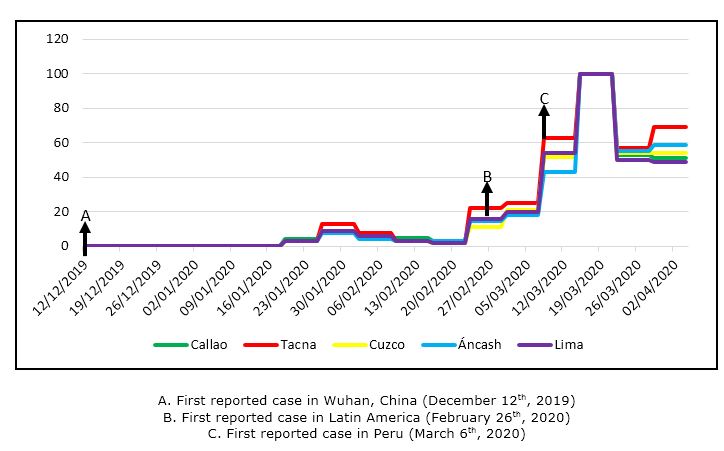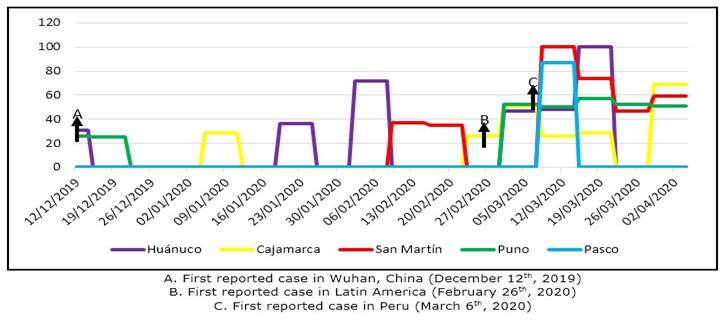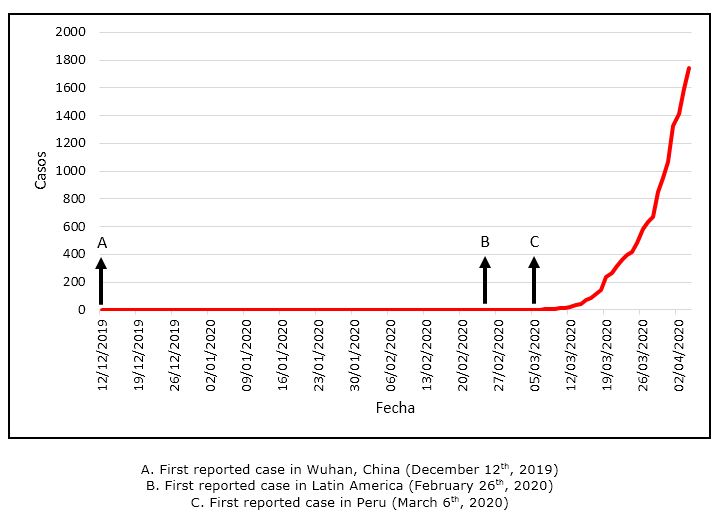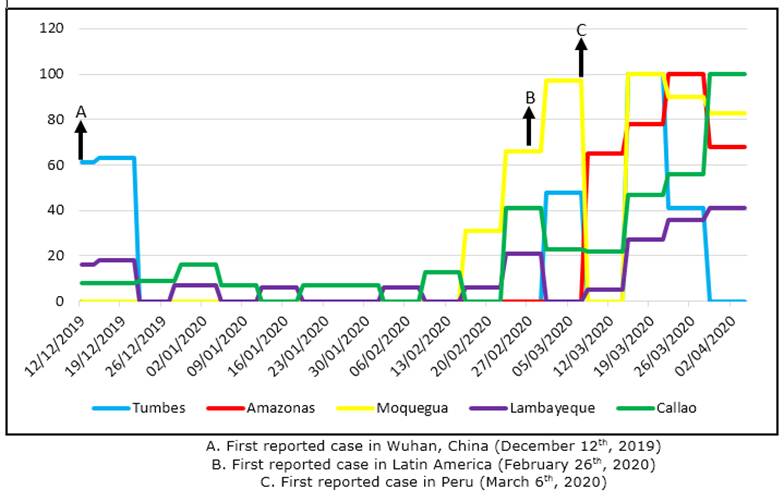Mi SciELO
Servicios Personalizados
Revista
Articulo
Indicadores
-
 Citado por SciELO
Citado por SciELO
Links relacionados
-
 Similares en
SciELO
Similares en
SciELO
Compartir
Revista de Ciencias Médicas de Pinar del Río
versión On-line ISSN 1561-3194
Rev Ciencias Médicas vol.24 no.4 Pinar del Río jul.-ago. 2020 Epub 01-Jul-2020
Original article
Aplicaciones de búsqueda de Google para la comunicación de riesgos en el manejo de la COVID-19
1Facultad de Ciencias Biológicas de la Universidad Nacional Pedro Ruiz Gallo. Lambayeque, Perú
Introduction:
search trends are what users show when they search on the Internet for an event, place, person or thing that the whole community is talking about, or that they are starting to talk more and more about and want to know why it is related to a topic or event.
Objective:
this study explored the potential use of Google applications to describe the trends in Google searches for terms associated with COVID-19 in Peru.
Methods:
Google search results were analyzed according to a geographic location. A relative search volume (RSV or Google Trends Index) is assigned to the keywords (coronavirus, hand-washing and masks), standardizing it from 0 to 100, where 100 represents the largest proportion of the term in a time series. Trends eliminate repeated searches for it.
Results:
searches related to COVID-19 and masks in Peru increased rapidly, following announcements of the first case imported from Brazil, and peaked when local cases were reported. The level of interest of each term by departments in Peru was observed, as a result it was found that for the term coronavirus were: Callao, Tacna, Cuzco, Áncash and Lima the ones that searched more and for the term hand-washing were: Huánuco, Cajamarca, San Martín, Puno and Pasco, and the term masks: Tumbes, Amazonas, Moquegua, Lambayeque and Callao.
Conclusion:
in response to the pandemic, our results showed that Google Trends could potentially define the right time and location to practice appropriate risk communication strategies for the affected population by the government.
MeHS: COMMUNICATION; RISK; COMMUNICABLE DISEASES; PERU; CORONAVIRUS INFECTIONS
INTRODUCTION
On December 31, 2019, the World Health Organization (WHO) was informed in China of cases of pneumonia of unknown etiology detected in the city of Wuhan, Hubei Province of China. 1The outbreak is associated with exposures in a market of seafood and wild products in a market in the city of Wuhan, it was called New Coronavirus (2019-nCoV). (2
On 13 January 2020, the Ministry of Public Health of Thailand reported the first laboratory-confirmed imported case (2019-nCoV) from Wuhan, Hubei Province, China.1 Coronavirus disease 2019 (COVID-19) has spread rapidly around the world since the first reports from Wuhan in China in December 2019, and the outbreak was characterized as a pandemic by the WHO on 11 March 2020.
Coronaviruses are enveloped RNA viruses that belong to the family Coronaviridae and are widely distributed in humans and other mammals. Although most human coronavirus infections are mild, epidemics of the two betacoronaviruses, severe acute respiratory syndrome coronaviruses (SARS-CoV-2) 3,4
Google Trends (WG) can provide information on population behavior and health-related phenomena, uses a fraction of the searches for a specific term ("keyword" or "search term"), and then analyses the Google search result according to a given geographical location and a defined period of time. And it's important to note that Trends only show data for popular terms (low volume is shown as 0). Relative popularity is calculated as a ratio of the Web search queries volume to the total number of searches. These values are scaled proportionally so that the maximum value is 100.
Given the pandemic, strong risk communication is urgently needed, particularly in affected areas. Therefore, this study explored the potential use of Google Trends (WG) to monitor public concern about the COVID-19 epidemic infection in Peru.
METHODS
The present research is cross-sectional, it consisted of the use of Google Trends (WG) looking for the terms social distancing, virus, prevention methods, medicines ("coronavirus", "hand washing" and "masks"), in Peru. Data from 115 days since the first WHO report in China were analyzed. The WG search was conducted on April 8, 2020.
The terms related to coronavirus, hand washing and TG masks were obtained from January 1, 2020 to April 4, 2020 in Google trends (trends.google.es/trends). These search terms represented the search for information for COVID-19 and personal hygiene practice to prevent disease transmission. Data regarding search volume was filtered by geographical regions in Peru and the most voluminous keyword searches were chosen.
The WG data were then compared with the daily data on COVID-19 cases obtained from the Peruvian Ministry of Health website and processed in Microsoft Excel using the data from standardized searches on a scale of 1 to 100 points. Data on the number of infections was obtained from each COVID-19 Situation Room in each country studied up to April 25, 2020.
RESULTS
When on April 4, 1746 cases of COVID-19 were reported in Peru. The first case was reported on March 6 of the same year (Graph 1 ).
It was evident that COVID-19 cases were reported in Wuhan, Latin America and Peru, the level of search in WGs for the terms "coronavirus", "hand washing" and "mask" was increasing in Peru. However, by the end of March, the level of search for "coronavirus" decreased slightly compared to the other two terms (Graph. 2 ).

Graph. 2 Search level of the terms "coronavirus", "hand washing" and "mask" related to the first reports of COVID-19 in Wuhan, Latin America and Peru.
Based on the term "coronavirus" the departments that registered the greatest number of searches were Tacna, Callao, Cuzco, Ancash and Lima. It was observed that the search volume of the mentioned regions was similar over time and that it is directly proportional to the increase in cases of COVID-19 in Peru, decreasing slightly at the end of March (Graph. 3 ).

Graph 3 Search level of the term "coronavirus" related to the first reports of COVID-19 in Wuhan, Latin America and Peru
With respect to the term "hand washing", the departments that carried out the most searches were Huánuco, Cajamarca, San Martin, Puno and Pasco, where it could be seen that some of these regions registered a high level of searches when the first case had already been reported in Wuhan and in Latin America, and when cases began to be reported in Peru, the level of searches in the regions rose to its highest level (Graph. 4 ).

Graph 4 Level of search for the term "hand washing" related to early COVID-19 reports in Wuhan, Latin America and Peru.
With respect to the term "masks", the departments that carried out the most searches were Tumbes, Amazonas, Moquegua, Lambayeque and Callao, of which some of them registered a discrete search level when the first case had already been reported worldwide, reaching a peak when cases began to be reported in Peru and at the end of March some of them had a decreased search level. (Graph. 5)
DISCUSSION
Searches related to COVID-19 in Peru remained low in the period when the first case was detected in China (5 and increased continuously with the announcement of the first case imported from Peru on March 6th, 2020. 6 However, searches related to COVID-19 in Peru continued to expand and peaked on March 15th for the term coronavirus, March 8th for the term hand washing and March 29th for the term masks, just as cases were progressively increasing in that country, this increased public concern to generate huge purchases of face masks leading to a shortage of face masks in Taiwan as well as in Peru. 7 A similar study shows that the information generated can be used for risk communication purposes in the management of infectious diseases and the use of information from the population of a geographical area. 7,8
Searches related to COVID-19 took 70-90 days to peak since the first case was reported in Wuhan and decreased continuously after more than 1000 cases were reported nationally,6 this same trend was detected in this study but with a volume maintained for the word COVID-19. Globally, an increase in related searches was also detected following the same trend that arises worldwide and in China. 8
In addition, it was evident that there is a high level of interest from the population regarding the use of masks since until April 4th the related searches in WGs have been increasing massively. Similarly, searches for information related to hand washing were increasing as the number of cases for COVID-19 increased but with respect to the term masks, the level of interest in hand washing was lower.
This condition indicated that people were still collecting information on hand washing practices necessary for personal hygiene and protection while not wearing masks. And as for the term coronavirus, it only showed interest when the first cases of COVID-19 were reported in Peru, then dropped sharply in late March. The dynamics of the WG data in Peru was related to vulnerability due to the confirmation of COVID-19 in that country. Therefore, the WG data could be used to frame the appropriate time for risk communications to the public.
One of the limitations of the study is that low levels of searches are shown as 0, in addition to the fact that it could not be determined, why certain regions had more volume of searches on certain key words.
There is an imperative need to provide adequate information during the pandemic through risk communication. Proper risk communication could help to prevent excessive amount of information circulating in affected populations which could cause public concern or panic. In response to the ongoing pandemic, the results of this study demonstrated that WGs could potentially define the appropriate time and location for risk communication in Peru.
REFERENCES
1. OMS. Situation Report-11 Novel Coronavirus (2019-ncov). WHO [Internet]. World Health Organization; 31 January 2020 [citado 18/06/2020]. Disponible en: Disponible en: https://www.who.int/docs/default-source/coronaviruse/situation-reports/20200131-sitrep-11-ncov.pdf?sfvrsn=de7c0f7_4 [ Links ]
2. Rothan HA, Byrareddy SN. The epidemiology and pathogenesis of coronavirus disease (COVID-19) outbreak. J Autoimmun [Internet]. 2020 [citado 18/06/2020]; 109: 102433. Disponible en: Disponible en: https://pubmed.ncbi.nlm.nih.gov/32113704/ [ Links ]
3. Huang C, Wang Y, Li X, et al. Clinical features of patients infected with 2019 novel coronavirus in Wuhan, China. Lancet [Internet]. 2020 [citado 18/06/2020]; 395(10223): 497-506. Disponible en: Disponible en: https://pubmed.ncbi.nlm.nih.gov/31986264/ [ Links ]
4. Kuiken T, Fouchier RAM, Schutten M, et al. Newly discovered coronavirus as the primary cause of severe acute respiratory syndrome. Lancet [Internet]. 2003 [citado 18/06/2020]; 362(9380):263-270. Disponible en: Disponible en: https://pubmed.ncbi.nlm.nih.gov/12892955/ [ Links ]
5. OMS. Brote de Enfermedad Por Coronavirus (COVID-19): Orientaciones Para El Público [Internet]. World Health Organization; 2020 [citado 18/06/2020]. Disponible en: Disponible en: https://www.who.int/es/emergencies/diseases/novel-coronavirus-2019/advice-for-public [ Links ]
6. Ministerio de Salud. Sala Situacional COVID-19 Perú. 2020. MINSA [citado 18/06/2020]. Disponible en: Disponible en: https://covid19.minsa.gob.pe/sala_situacional.asp [ Links ]
7. Husnayain A, Fuad A, Su EC-Y. Applications of google search trends for risk communication in infectious disease management: A case study of COVID-19 outbreak in Taiwan. Int J Infect Dis [Internet]. March 2020 [citado 18/06/2020]; 95: 221-223. Disponible en: https://www.ijidonline.com/article/S1201-9712(20)30140-5/fulltext [ Links ]
8. Strzelecki A. Infodemiological Study Using Google Trends on Coronavirus Epidemic in Wuhan, China. International Journal of Online and Biomedical Engineering [Internet]. January 2020 [citado 18/06/2020]; 16(4): 139-146. Disponible en: Disponible en: https://arxiv.org/abs/2001.11021 [ Links ]
Funding sources
Received: May 03, 2020; Accepted: June 30, 2020











 texto en
texto en 





